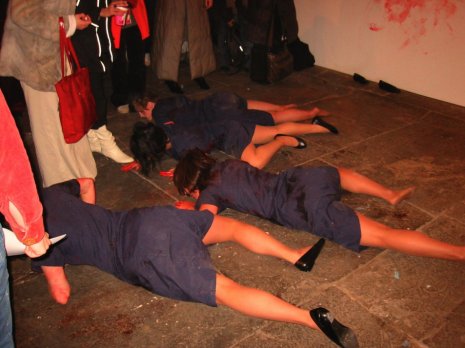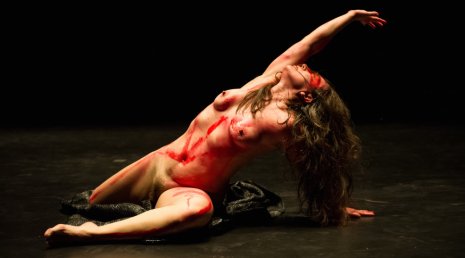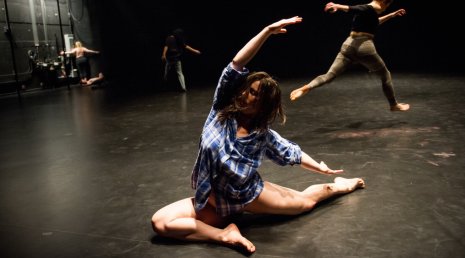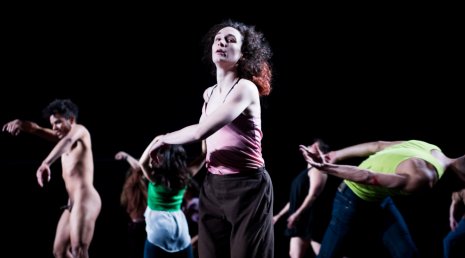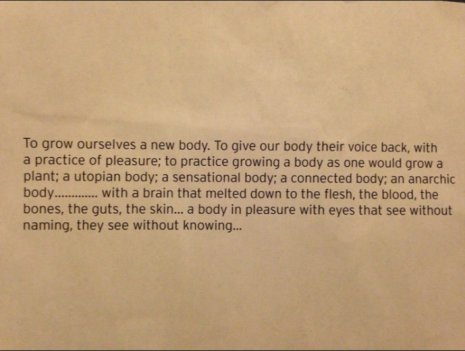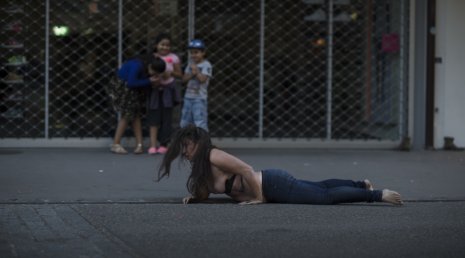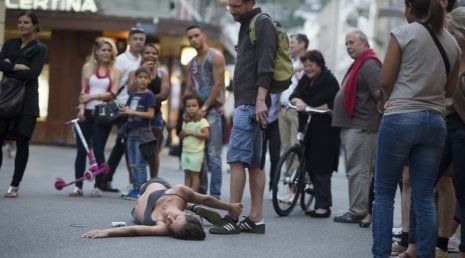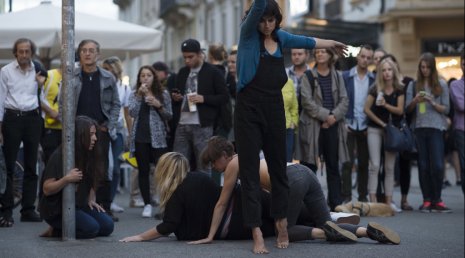Chapter One
This email conversation between luciana achugar, in New York, and Lucía Naser*, in Uruguay, began on March 8, 2017 and continued through April.
I got excited for you asking me this question on this very special women's day because it grounded this conversation in a moment in time and that is what dance reminds us of always. If I remember correctly from some of the feminist theory that I've read, there is often a mention of how a woman's body - with it's monthly menstruation, its PMS-ing, growing womb belly, swollen feeding breasts, tears, high pitched voice or cackle, etc… - has a way of preventing us from being able to forget that we exist as a BODY, not as separate from it. Women’s bodies remind us more of our flesh, our hormonal changes, cycles of the moon, kids that need tending too, the cleaning of the poop, the throw up, the thick smelly blood of the menstruation... This inability and inevitability - or perhaps unwillingness and choice - to not escape the BODY in its full messy and complex nature, an inherent and all encompassing aspect of being, is no different than what dance as a practice and as a choice of life is for me. This feminist proposal of the possibility of liberating ourselves from an oppressive dualist-Cartesian-hierarchical way of being in the body, this way of being and perceiving the world, this way of valuing things, finds ground in the dancing body, standing in the ground. In my dancing female body…standing with my womb in my pelvis on my legs…with my feet feeling the ground as if being fed by it - not on top of it but growing from it…
I feel the desire to find in this language (perhaps a more poetic relationship to it than a "pedestrian" interview?) more an approximation of my dances and my dancing body. Feminism to me is about changing the prevailing discourse. I begin from inside of my body, my perception, my embodiment, (perhaps the possibility of an embodied rebellion rather than a revolution?) As I was saying, to write on this day of women marching all over the world…I must be honest and confess that I haven't felt totally identified with some of the discourse coming out right now from the women's movement here in the USA. I have been feeling like a bit of an isolationist or dissenting from the larger feminist agenda here. I definitely wasn't feeling the "pussy hat" thing. I got the reference to Trump's hideous words, but I couldn't help but see a bunch of pink hats on people's heads looking like nothing other than white shaved vaginas. Strange how disturbing it felt to me, considering that I have been performing work naked for a while and make my work very much as a practice of ridding oneself of the shame that has been put upon the body in general and on women's bodies in particular. This pink hairless pussy felt incredibly facile, a simplification, an American appropriation for the liberals to take on comfortably, with no hair and no color and definitely no talk about the oppression and patriarchy inherent in Imperialism (aka Permanent WAR!!!). I know that some more radical feminists are calling out such hypocrisy and referring to it as white feminism, calling for an intersectional feminist movement, but I really hope this includes criticism of American Exceptionalism that I see as nothing other than another form of racism and colonialism.
And then…I remember that I chose to ask someone like you, a woman, an artist, a thinker, being in Montevideo, in Uruguay…I asked you, Lucía Naser, to ask me questions, perhaps because my work and "my" feminism are inseparably connected/connecting being in a female-identified dancing body and being from Uruguay; because my work is dealing with (practicing, doing) an embodied feminine empowered ideology from a third world country perspective that is highly aware of its postcolonial reality and it's disempowered relationship to the first world.
Unfortunately, (or not), I didn't answer right away and I let time go by and got fearful as to how I would respond to such a complex and loaded question and find the words that could articulate the complex and somewhat abstract and, at times, esoteric relationship that my being in a woman's body, or rather identifying as female, has with my practice of making dances and how it is somewhat connected with feminism…!
Interestingly, after a day or two, I watched a clip from the march that happened in Montevideo in a plaza filled with what seem to be mostly women in concentric circles - not unlike a lot of what keeps recurring in my work - a very universal shape, I know - but nonetheless a profound and naturally occurring shape when there is a collective of bodies gathering, rhythmically jumping together as they chant "Somos las nietas de todas las brujas que nunca pudieron quemar!" (“We are the granddaughters of all the witches that they weren't able to burn!”). This circle chanting street protest in the context of the women’s march feels both like a ritual and a protest and the jumping has exactly the same rhythm as the pounding that we did in the theater in "OTRO TEATRO" (which you can probably remember well since you participated in both the NYC and Montevideo versions of it).
All of a sudden, in this 2-minute clip, I'm seeing my work in all of its political intention represented on the streets in the women's march! Ha! It made me feel both so overly obvious with what I've been trying to do and at the same time so thrilled that I feel such a strong connection to these young women doing this chant in a circle, jumping up and down right now in this historical moment that is calling for a true embodied rebellion! It occurs to me that it isn’t such a coincidence that the women’s movement is building such momentum again, and the fact that these young women refer to being the granddaughters of the witches that were spared being burnt makes me feel both incredibly hopeful, inspired and at the same time made me feel validated in terms of how relevant perhaps the work I’ve been doing has been after all.
The references to the Witch in my work have been recurring for a very long time. It began as if by chance, appearing almost on its own through my own improvisations and via working with a group of only women for a very long time. I didn't quite understand it in a conscious way at first because I never intended to bring in those references, they seemed too stereotypical to me…somewhat of a facile and perhaps even chauvinist obvious association to being a woman, being a witch...perhaps self hatred or shame of the strength in my body was leading me to this caricature of a strong woman's body as a witch, someone to be burned alive, shamed, disposed of?
But, as time went by, I realized that “the Witch” was within me, in the memory of my flesh; I realized that the deeper I went into my practice (of what I used to call simply performing desire, which later became "the practice of being in the pleasure of being in one's body," aka practice of pleasure or pleasure practice, or within our rehearsals simply "the Practice”) that it truly was both the repressed and suppressed side of me that only was able to come out with time, by going deeply into the body and letting go of assumptions of ways of being in one's body. Most importantly when I let go of my "identity," when I let go of being "luciana" and allowed what was deep in the felt part of myself, what I later began to call the “uncivilized,” then what emerged was a more primal, animal, sensual, sexually unashamed, grounded, powerful and at times even dark and witch-like Other self. But it was coming from the desire to be lost in the experience of being connected or more present, of being more aware and sensitive, being in the full and verging on the magical experience that is being a live body. Either a desire to be or a memory of having been a witch was lying dormant in my cells! A desire that is none other than the same desire to be more of a whole self and a holy self; a desire to unite the physical with the emotional and the spiritual, and to feel wholly empowered and unashamed of all of it; so as not to put one aspect or part of ourselves above another, but to be in a relational experience with all of it. And, to think of it in terms of “choreography,” to be in more of a circle or spiral relationship with everything than in a line.
Also, I very much identified with the footage of the protest because I've felt that in my work there always ends up being a kind of rage that comes out from deep within me, either in my own presence onstage or in the rhythm of the composition of the work I make; and most certainly in the works' persistent positioning of itself as something very self effacing, transparent, raw and able to unearth the shadow (as in Jungian psychology’s concept of the shadow); to face and come to terms with the shadow within the work itself and within each performer; and, in turn, also to make the audience face itself and its shadow, which to me is partly the voyeuristic and passive role that the audience collective plays by the mere act of attending a performance and agreeing to the contract of playing the part of the viewer - the voyeur (and which, as I experience it, always refers back to the objectifying male gaze).
Working only with women for many years brought about this same witch like feeling between us; it often felt like we were creating a coven by being together for hours, that turned into days, months, and then years of practicing being in our bodies, and ways to connect more deeply and to let go and to celebrate each other and the connection between us. Often we would end up organically gravitating to a circle, breathing together, making sounds often coming from our pelvises or guts and the energy of the space and what we were doing would build up so much that it felt like we were brewing some kind of magic potion! It seems comical perhaps when I say it but the experience of doing it and the energetic build up was super real and felt profound.
What would you say is the role of transformation in your work? How have your own thoughts and experiences of transformation mutated along your personal history as artist and woman?
[interview continues in Chapter Two...]


